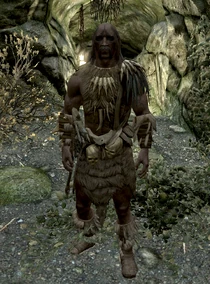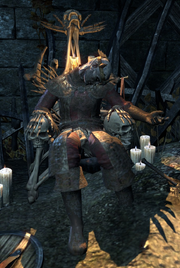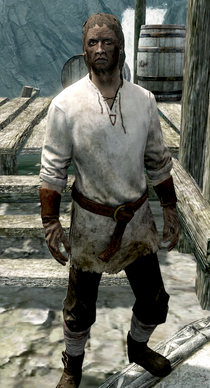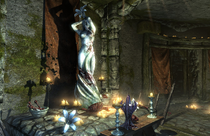
Typical Reachman seen in The Elder Scrolls V: Skyrim.
- For Reachmen in The Elder Scrolls Online, see Reachmen (Online).
- "Only those of the Reach know the ways of the Reach."
- ―Lord Trystan[src]
The Reachmen are a group of ethnic Bretons native to the Western Reach and later the Reach. They are often considered barbaric savages by the other races of Tamriel and are well known as the "Witchmen of High Rock."[1] While they are mostly Breton in stock, the Reachmen do not consider themselves as such.[OOG 1]
Biology
Due to the converging location of the Reach on the borders of Skyrim, Hammerfell, and High Rock the Reachmen share ancestry with many of the other Human and Elf races of Tamriel. Their origins can be traced back to when Men and Mer first began breeding within the Western Reach. During the War of Succession, the Elves of High Rock massacred the Nord population living in the occupied Western Reach, and because of this, the Reachmen owe most of their ancestry to Bretons and Elves. The Reachmen were also believed to have interbred with Nedes, Imperials, Daedra, and Orsimer.[1][2]
History
First Era
It is stated that the Nords had never discovered Nedes or Manmeri until they first began entering the lands beyond their borders during the Skyrim Conquests.[1][3] Because of this, it is likely that the Reachmen first began immigrating into the Reach of Skyrim sometime during or between the Conquests and the War of Succession, most likely when the western portions of Skyrim, including the Reach, had been conquered by the Direnni Hegemony, who had held control of the Reachmen's indigenous lands during the time.[4][5] Sometime around 1E 500, the Reachmen would begin a bloody uprising against the Direnni Elves, claiming the Western Reach, and possibly the, Direnni occupied, Reach of Skyrim, for their own kind. In this uprising, almost all the Altmeri inhabitants of the Western Reach were exterminated.[1] The Reachmen were said to have taken up residence in Markarth shortly after the Dwemer disappeared around 1E 700.[6]
Siege of Orsinium
During the Thirty-Year Siege of Orsinium, the Winterborn clan was allied with the forces of Daggerfall, Sentinel, Knights of the Dragon, and commanded by General Mercedene, the "Beast of the Reach," as mercenaries hired by King Joile. The Winterborn were previously commanded by Evandene, who lost her title when she refused to kill civilians of a village. Her daughter Mercedene challenged her on the spot, killed her, cut our her heart, and ate it. Taking command of the Winterborn, she shot the villagers full of arrows and had her mother's corpse decorating an altar to Malacath.[7][8]
Sometime between 1E 952 and 1E 973, Mercedene captured Rokaug, the brother of famed Orcish hero Baloth Bloodtusk. Under Joile's orders, she had to set up a duel between Gaiden Shinji and Baloth. To do this, she had Joile threaten Shinji that if he didn't accept, Lord Trystan would go in his place. She and Joile then manipulated Baloth by telling him his brother Rokaug died at her Winterborn forces, causing him to ally with King Golkarr of Orsinium.[7][9]
During the duel, as Shinji and Baloth were fighting, Mercedene had Joile's Archers assassinate them both, eliminating the most powerful soldiers of both Orsinium and Hammerfell. Lord Trystan discovered this plot shortly before-hand, but was too late to save the heroes. He ordered Commander Reliana to kill Mercedene for her betrayal, and the Winterborn commander died at her hands. Trystan, Reliana, and Rokaug left Mercedene's body in Orsinium, where she would later rise as a Wispmother known as "Mercedene the Cursed." Joile did not let Mercedene's sacrifice go in vain, and later executed his invasion of Hammerfell, but died during the Battle of Bangkorai Pass.[7][8][10]
The Red Eagle
The Reachmen rule over the Reach would continue on until the 11th century of the First Era. The Reach at this time was made up of ten, scattered, warring kingdoms, with the most notable of them being known as the Sundered Hills, where the Reachman hero, Faolan, better known as Red Eagle, was born. The Red Eagle was prophesied to bring peace to the ten warring kingdoms and unite them all into one, collective, kingdom. However, in 1E 1030, the Reach was invaded by the Alessian Empress, Hestra. The Alessians conquered each kingdom, one by one, until only the Sundered Hills remained. The Empress sent envoys to negotiate a surrender with Faolan, but when he refused, the Elders of his kingdom exiled him and ceded the Sundered Hills to Hestra. In order to reclaim the Reach from the Empire, Faolan formed a resistance group made up of traditional Reachmen, using the Reach's myriad of cave systems to raid Imperial garrisons and the Reachmen that betrayed them. After being visited by a Hagraven, the Red Eagle willingly gave up his humanity to become, possibly, the first Briarheart and a spirit of pure vengeance for his people. The Red Eagle's rebellion would spread throughout the Reach, raising in strength and numbers, and after two years, the Reach had been almost completely removed of the Empire's influence. Fearing defeat, Hestra sent a much larger army to secure the Reach under her control and besieged the Red Eagle's stronghold for two weeks until Faolan's defense fell and the Reach was brought into the Empires control again.[11]
Reman Empire
After the first Akaviri Invasion in 1E 2703, the Emperor Reman Cyrodiil moved his focus to the Reach, splitting the region between Imperial controlled High Rock and Skyrim in order to stop Reachmen raids on mines in the region. Armies from Evermore and Solitude were consistently brought into the Reach to keep stability in the area.[2] Reachmen were said to raid locations as far as Bruma during this time.[12] During the reign of Emperor Kastav and the Winterhold Rebellion of 1E 2804, local Reachmen helped aid the Dragonguard with supplies in the two year long siege of Sky Haven Temple.[13]
Second Era
The Interregnum

The corpse of Emperor Leovic, the last Longhouse Emperor.
Many years later, during the Interregnum of the Second Era, the Reach once again became an independent state. During this time, many border wars were fought between the Reachmen and the holds that surrounded the Reach. The Reachmen invaded Cyrodiil at some point, being led by a man by the name of Durcorach the Black Drake, and created a rather short lived dynasty of Reachmen commonly known as the "longhouse clan."[14][15] In 2E 541, Durcorach attempted to expand his empire by invading High Rock. Durcorach conquered the lands of Bankorgai, Evermore, Hallin's Stand, and Camlorn. The young king, Emeric, was able to hold Wayrest through the invasion, and turned the tide of the war after defeating the Reachmen at Daggerfall. The Reachmen Invasion of High Rock helped to unify the province and was highly responsible for the creation of the Daggerfall Covenant.[16] The longhouse clan would rule over the fractured Empire for almost thirty years before being deposed by Varen Aquilarios.[15] During the Three Banners War of 2E 580, some Reachmen were known to have aided Molag Bal's plot to fuse Nirn with Coldharbour,[17] as well as pester both the Daggerfall Covenant and Ebonheart Pact.[OOG 1] In later years, some Reachmen allied themselves with the Second Aldmeri Dominion,[18] while other Reachmen groups would, instead, come into conflict with the Dominion.[OOG 2]
The Reach was eventually reconquered by Hjalti Early-Beard in 2E 852 during the closing years of the Interregnum, and the Reachmen were forced to live under the rule of the new Septim Empire.[19] During the period of early occupation, the Reach was put under the direct control of Provisional Governor Titus Alorius to see the region evolve into a new era of peace and prosperity.[1]
Fourth Era
The Forsworn Uprising

A native laborer inside Markarth.
Since the Interregnum, the Reach remained a hold of Skyrim until the Great War when a group of rebellious Reachmen known as the Forsworn, believing themselves the rightful rulers of the Reach, captured the capital city, Markarth, in 4E 174, with the intention of removing Nordic influence from the Reach and restoring the 'Old Ways' to their people.[20][21][22][23] With the armies of the Empire out fighting the war, the Forsworn easily took the Reach for themselves, establishing their own, self-proclaimed, independent kingdom. Their king, Madanach, ruled over the Reach. While some scoff at the idea of the Reachmen's government being anything more than a chaotic uprising,[24] others claim that Madanach ruled relatively justly, with only a few crimes occasionally committed against former Nordic landowners.[25] After the war with the Aldmeri Dominion, Madanach petitioned the Empire to be recognized as a legitimate kingdom.[25][24]
The Markarth Incident
Jarl Hrolfdir of Markarth and his son Igmund, in their desperate attempt to reclaim the Reach from their usurpers, organized a militia led by Ulfric Stormcloak, with the promise of free Talos worship within the city. The militia reclaimed the Reach from the Reachmen during the event later known as the Markarth Incident in 4E 176,[24][25] killing off a large number of those they considered associated with the rebellion or in any way responsible for the city's falling,[21][26] and allegedly, murdered any citizen who did not do their part to fight the Forsworn, though this may just be hyperbolization in order to slander Ulfric Stormcloak.[25] When the Thalmor found out about Hrolfdir and Igmund's deal, the Empire was forced to arrest all the members of the militia, as they were violating the White-Gold Concordat, causing the event to become a key cause for the Skyrim Civil War.[24][27] A large number of the Reachmen fled the city, running to the hills to continue their rebellion, becoming the contemporary Forsworn. Jarl Hrolfdir attempted to make peace with them only to be murdered in the process, with his shield being gifted to Hagravens.[24] Contempt for the Nords only grew, with the Forsworn now claiming they would kill off all the Nords that ruled the Reach.[28]
The Forsworn Conspiracy
After the Markarth Incident, Thonar Silver-Blood saw the potential usefulness of the Forsworn to advance his families control of the Hold, and used his influence to secretly spare Madanach from execution, making him, and the remaining Forsworn rebels, his personal puppets. This implies that Jarl Hrolfdir's assassination was possibly under Thonar's command.[29][24] During this time, many mines and their owners were targeted by the Forsworn for the purpose of allowing the Silverblood family to take their lands under their own protection.[30][31][32] Using his wealth to put the Markarth Guards in his pocket, Thonar was able to effectively prevent the investigation of these attacks,[30] as well as to hold the Reachmen within a low social-hierarchy to create a convenient, and cheap, labor force.[33] Thonar would continue to use the Forsworn to benefit his own agenda of gaining widespread control over the Reach and its inhabitants, until 4E 201 when Madanach began to rebel against Thonar's orders and continued the ideals of the original Forsworn Uprising.[29][22]
The Old Ways
While by the Fourth Era, most Reachmen had given up their more extreme traditional values, some groups, most notably the Forsworn, continued to follow the traditions of their ancestors, being known as the 'Old Ways'. These 'Old Ways' are considered by many to be archaic and cruel, being said to only lead to ruin for the Reachmen.[23]
Religion
The traditional Reachmen are often described as being barbaric Daedra worshipping savages, that revere and placate Hagravens.[34][35][OOG 3] The exact gods that the Reachmen worship are not clearly defined, but they seem to worship their own distinct pantheon they refer to as the Old Gods. The Reachmen's glorification of Hagravens hints that they may worship Daedra, but various shrines to the Divines found in Forsworn camps seem to contradict this. It is highly likely that some Reachmen worship both Aedra and Daedra, or at least began worshiping Aedra in later years. Another possibility is that some of the previously civilized Forsworn tribesmen have not fully given up the gods of Imperial tradition.[36]
Traditionally, worship varied from tribe to tribe, as certain groups were known to center their worship on specific gods. For example, the Crow-Wife Clan situated near Evermore primarily worshiped the Daedric Prince Namira.[37] The most commonly seen recipient of Reachmen worship is Hircine,[2] with some clans seemingly developing entire pantheons around him based on his five stated aspects, Alrabeg, Storihbeg, Uricanbeg, Gulibeg, and Hrokkibeg, each represented by specified animal spirit.[38] The Reachmen's worship of these more feral aspects of Hircine have put them at odds with some of the Witch clans of High Rock, who view him in a much less vicious light.[39] Additional Daedra some Reachmen are said to worship are Malacath and Mehrunes Dagon,[2] while none are known to worship Sanguine or Clavicus Vile. Some have even speculated that the Reachmen may even have their own unknown pantheon of deities, unidentifiable to other religions, worshiped through ancient totems and talismans.[OOG 3]
The observed Reachmen religion centers around the practice violent rites. Such rituals include self-flagellation, scarring, live burnings, bathing in blood, dismemberment, and possibly cannibalism, with some clans even being known to sacrifice children by cutting out their still beating heart. Werewolves and other such creatures are highly praised by Reachmen, being perceived as a blessing from Hircine, rather than a curse. Reachmen shamans often practice rituals with Hagravens in order to master certain nature magics, with some, known as Gravesingers, dabbling in Necromancy.[2][37][OOG 3]

The bloodstained shrine to Dibella. Fjotra's cage can be seen on the right.
Reachmen association with the Aedra has been noted with Forsworn clansmen, although their names for these gods, if any, are unknown. In Broken Tower Redoubt a Shrine of Dibella can be seen. At the shrine, a Forsworn Briarheart not only performs what appears to be blood sacrifices at the statue, but also kidnaps Fjotra, a Sybil of Dibella, and imprisons her in a cage. While possibly a barbaric form of worship, the ritual could also be interpreted as some purposeful form of desecration.[40] Additionally, Fort Sungard, while under the control of the Forsworn, possesses a shrine to Kynareth; while if the Legion controls it, it will be for Akatosh; and if the Stormcloaks control it, a shrine of Talos will be present.[36]
Culture
The traditional Reachmen seem to have a very deliberate tribal culture, wearing animal pelts and living in tents made of fur.[36] The Reachmen have a known disdain for the civilized societies and cultures of Tamriel.[OOG 3] Despite owning both The Reach and the Western Reach at various points in their history, they were never known to have established permanent settlements,[1][11] seemingly preferring to live in remote mountainous regions and caves.[37][16] The Reachmen view the Reach as some form of holy land gifted to them by Hircine, and so is defended ferociously by their kind.[2] The magicians of their tribes practice a variety of taboo magicks such as human sacrifice and the creation of Forsworn Briarhearts, a process in which is viewed as the pinnacle of warriorhood amongst the Reachmen.[2] For this reason, they are known as the "Witchmen of High Rock." It is believed that a large number of their taboo magicks were acquired through trade between the Reachmen of the Western Reach and the Orsimer tribes of the Wrothgarian Mountains.[1] The Reachmen are said to posses their own language, though there is no evidence of any written form, as all primary Reachmen documents are transcribed from oral tradition.[38][11] The most revered individual amongst the Reachmen is the legendary Red Eagle, who led the rebellion against the Empress Hestra in 1E 1030.[11][41] A prevalent Reachmen teaching is that subtlety and nuance are for the weak, and that the weak, in turn, deserve to be punished,[OOG 3] this can be seen in many of their violent rites of passage. A fair number of Reachmen tribes are notably matriarchal.[42]
The traditional Reachmen are also described as being very cruel, often kidnapping the inhabitants of villages and enslaving them. Firsthand accounts say that even the Reachmen's humor was normally dark and malicious,[37] being known to pull pranks that causes physical harm to others.[OOG 3] During times of war, the Reachmen were known to pillage, massacre, and raze any settlements they came across and were normally known to use overwhelming forces and speed when attacking cities rather than siege tactics, as they lacked proper siege weaponry and naval forces to do so.[16] When, raiding villages or other tribes, Reachmen are said to prefer sneak attacks, catching their enemy by surprise and then dominating them.[OOG 3] The Reachmen have been said to enjoy being enemies of the other races.[OOG 1] Despite this, some old Reachmen tribes were noted to have no problems trading peacefully with the cities of northern Tamriel.[42]
Clans
Throughout history, there have been multiple Reachmen clans. They are as follows:
- Bloodthorn Cult — Reachmen necromancers that attempted to conquer Glenumbra.
- Boneshaper Clan — A group of Reachmen that invaded The Rift.
- Dark Witnesses — Reachmen that attempted to capture Mournoth for the Reach.
- Forsworn — A modern-day clan of Reachmen that caused uproar and corruption throughout Markarth.
- Longhouse Emperors — A bloodline of three Emperors who ruled Cyrodiil for over 30 years.
- Rageclaw Clan — Another group of Reachmen that invaded the Rift.
- Stonetalon Clan — Another group of Reachmen that invaded the Rift.
- Winterborn — A long-active group of Reachmen that inhabited the Western Reach.
Appearances
- The Elder Scrolls Adventures: Redguard (mentioned only)
- The Elder Scrolls III: Morrowind (mentioned only)
- The Elder Scrolls IV: Oblivion (mentioned only)
- The Elder Scrolls V: Skyrim
- The Elder Scrolls Online
References
- ↑ 1.0 1.1 1.2 1.3 1.4 1.5 1.6 Pocket Guide to the Empire, First Edition: High Rock
- ↑ 2.0 2.1 2.2 2.3 2.4 2.5 2.6 The Emperor's Guide to Tamriel: Northern Bangkorai and the Mountains
- ↑ Frontier, Conquest
- ↑ Once
- ↑ Pocket Guide to the Empire, Third Edition: High Rock
- ↑ Dialogue with Kibell
- ↑ 7.0 7.1 7.2 The Ashes of Our Fathers Quest
- ↑ 8.0 8.1 King Joile's Orders to General Mercedene
- ↑ Letter to Baloth Bloodtusk
- ↑ From the Memory Stone of Makela Leki
- ↑ 11.0 11.1 11.2 11.3 The Legend of Red Eagle
- ↑ Racial Motifs 12: The Barbaric
- ↑ Annals of the Dragonguard
- ↑ Chronicles of the Five Companions 1
- ↑ 15.0 15.1 Chronicles of the Five Companions 4
- ↑ 16.0 16.1 16.2 Travails and Triumphs of a Monarch
- ↑ Events of The Elder Scrolls Online
- ↑ Pocket Guide to the Empire, First Edition: Aldmeri Dominion
- ↑ The Arcturian Heresy
- ↑ The Madmen of the Reach
- ↑ 21.0 21.1 Dialogue of Nepos the Nose
- ↑ 22.0 22.1 Dialogue of Madanach
- ↑ 23.0 23.1 Dialogue with Cedran
- ↑ 24.0 24.1 24.2 24.3 24.4 24.5 Dialogue of Jarl Igmund
- ↑ 25.0 25.1 25.2 25.3 The Bear of Markarth
- ↑ Dialogue of Braig
- ↑ Dialogue of Alvor
- ↑ Dialogue of Hogni Red-Arm
- ↑ 29.0 29.1 Dialogue of Thonar Silver-Blood
- ↑ 30.0 30.1 Dialogue of Eltrys
- ↑ Dialogue of Ainethach
- ↑ Dialogue of Pavo Attius
- ↑ Dialogue of Markarth Guard, The Forsworn Conspiracy
- ↑ Dialogue of Yngvar the Singer
- ↑ Herbane's Bestiary: Hagravens
- ↑ 36.0 36.1 36.2 Events of The Elder Scrolls V: Skyrim
- ↑ 37.0 37.1 37.2 37.3 A Life Barbaric and Brutal
- ↑ 38.0 38.1 Aspects of Lord Hircine
- ↑ The Glenmoril Wyrd
- ↑ The Heart of Dibella Quest.
- ↑ Red Eagle's Rite
- ↑ 42.0 42.1 Clans of the Reach: A Guide
| Races | |
|---|---|
| Humans | |
| Mer | |
| Beast | |
| Akaviri | |
| Et'Ada | |
